Almindsø Lake Dive Site
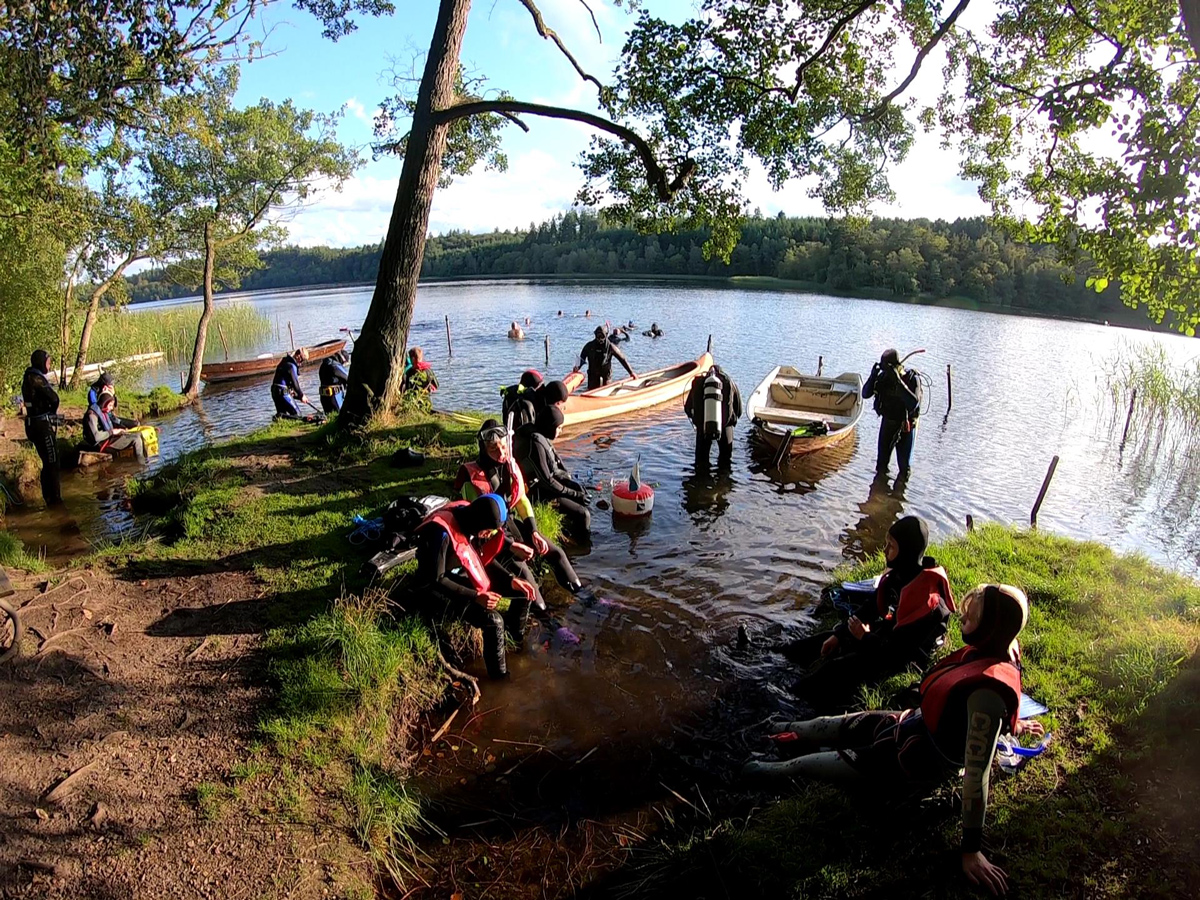
Introduction.
One of the skill building exercises of the PADI Divemaster education is a mapping project:
Have divemaster candidates in buddy teams survey an open water dive site and create a detailed map of the site showing (as applicable to the site) underwater relief, important points of interest, any relevant environmental notes, recommended entry/exit areas, local facilities and potential hazards.
The result of this drill is documented below and is supposed to be handed out to divers wanting to visit the lake in paper format. Methods are documented in "Divemaster Dive Site Mapping Drill – Methods and documentation."
General Description
Most lakes in Denmark are fed from water streams carrying sand and particles into the lake thus rendering the visibility near zero. Almindsø Lake is different: It is mostly fed through fresh and clean ground water seeping up from beneath and through springs at the south end, thus making it one of Denmark’s cleanest lakes with a visibility up to 7 metres. It is host to some 20 species of underwater plants and some 450 species of aquatic animals including plenty of pikes (Da: “gedde”) up to 1 metre of length and perches (Da: “aborre”) up to 50 cm length. Nearly every visiting diver gets to see these fish at close range. It has a circumference of close to 4 km, an area of 0.53 sq. kilometres, a max depth of 20.5 metres and an average depth of 10.5 metres. All flora and fauna are to be seen in the range 0 – 4 metres near the coastline, though. Below that, you will find nothing but mud and clay. It is located right next to Silkeborg, “The Outdoor Capital of Denmark” and is easily accessible. You can dive directly from parking areas at the east or west end. Silkeborg Scuba Club (Da: “Silkeborg Frømandsklub”) is located some 200 metres from the west end parking area. It is possible for organised divers to arrange with this club for guidance, tank filling, access to club house and more. Entry and exit are non-complicated, and the lake is considered an extremely safe diving spot for scuba divers and snorkel divers. Fishing is permitted with due licensing, but underwater hunting is not. Power boats are not allowed. Night diving is permitted and gives you a great chance to get close to aquatic life.
Silkeborg is a great and friendly place to take your entire family for diving, swimming, kayaking, canoeing, hiking, biking, art galleries, a trip with a genuine steamboat, wining and dining, shopping and much more
How to find Almindsø Lake

The lake is located at the south end of Silkeborg some 40 kilometres west of Aarhus. It has two popular swimming resorts referred to as “Swimming Resort East” and “Swimming Resort West. It is located at an altitude of 21 metres AMSL.
Resources
Bridges, dressing rooms, toilets, saunas and even coffee shops are available at both swimming resorts. We do not recommend using the bridges, though, because you would have to carry your gear for 2 – 400 metres. It is easier to enter the lake directly from the parking areas at east and west.
Tank filling (also with Nitrox), equipment cleaning, access to club house and some service facilities, toilets and emergency equipment can be arranged with Silkeborg Scuba Club for organised divers.
Rental gear is available in Aarhus, some 40 kilometres away. Thus, it is preferable to bring your own gear unless you plan to stay for a long time.
Entry-/Exit Points
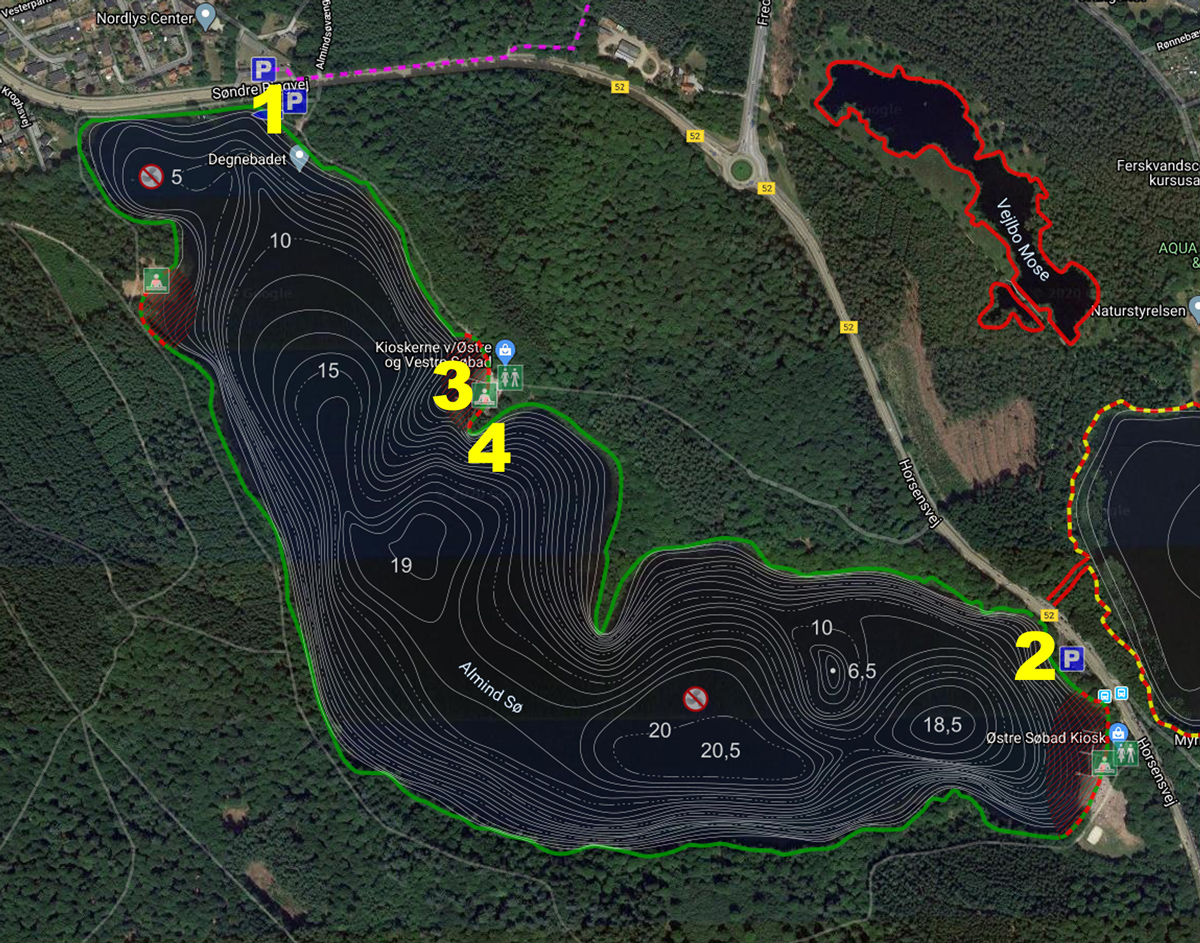
 Entry point 1 is located 200 metres from the club house of Silkeborg Scuba Club and right next to a parking lot. It even has picnic tables but no toilets. Entry-/Exit is very easy. You can walk in and out of the water through white beach sand. From here you have access to a safe diving area with shallow water up to 10 metres depth and areas of reed where you will find lots of freshwater fish.
Entry point 1 is located 200 metres from the club house of Silkeborg Scuba Club and right next to a parking lot. It even has picnic tables but no toilets. Entry-/Exit is very easy. You can walk in and out of the water through white beach sand. From here you have access to a safe diving area with shallow water up to 10 metres depth and areas of reed where you will find lots of freshwater fish.
Entry point 2 is located right next to the parking lot at Swimming Resort East and thus you have access to bathrooms, coffee kiosk, sauna etc. It is recommended not to carry your gear to the bridges but enter water directly from an entry right next to the parking lot. Entry-/Exit is very easy except that the bottom is made of mud that you will stir up, but you can walk through it without difficulty. From here you have access to areas of reed with fish and to deep water areas.
 |
 |
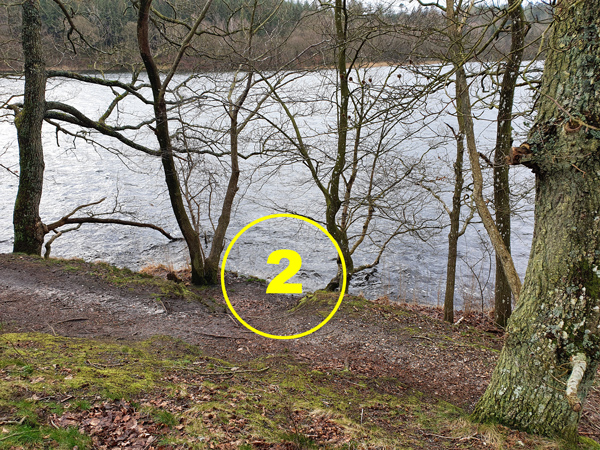 |
Entry point 3 is the bridge at “Swimming Resort West”. Entry point 4 is right next to it on the other side of the same ness. Here you have access to bathrooms, dressing facilities, picnic area, sauna, coffee kiosks but you cannot go there by car. You must carry your gear approx. 400 metres from the parking lot at the west end of the lake. From here you have access to areas of reed with fish and to deep water areas. From “3” you get directly into water about 2 metres deep. From “4” you will have to walk through mud, but it is firm enough that you can walk on it.
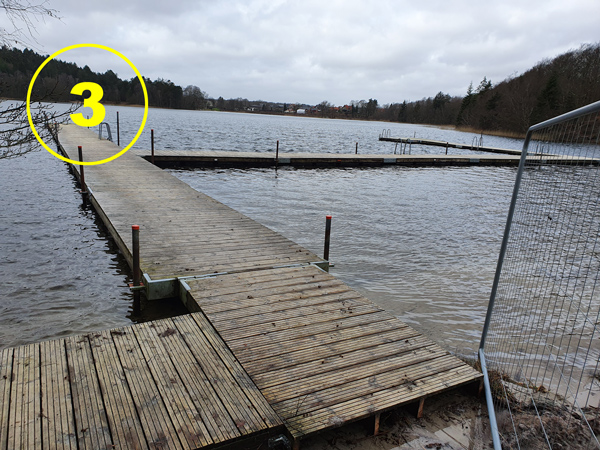 |
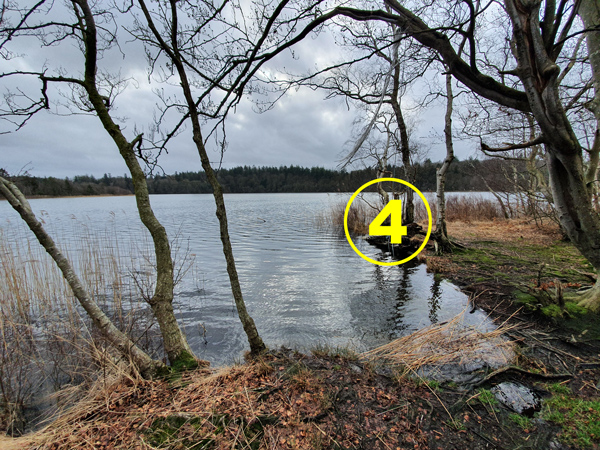 |
Points of interest
Reed forests with huge freshwater fish.
You will find these forests anywhere along the shores. Just go right or left from any entry point and you will find them. It is even easier to find the fish at night.
Tiny wreck at the north end of the lake.
From entry point 1, surface swim to the isolated trees at the north end of the lake towards “Søndre Ringgade”. Near the westernmost tree, descend and swim bearing 210° for 38 meters (~ 3 minutes). It lies at a depth of 3,5 metres.
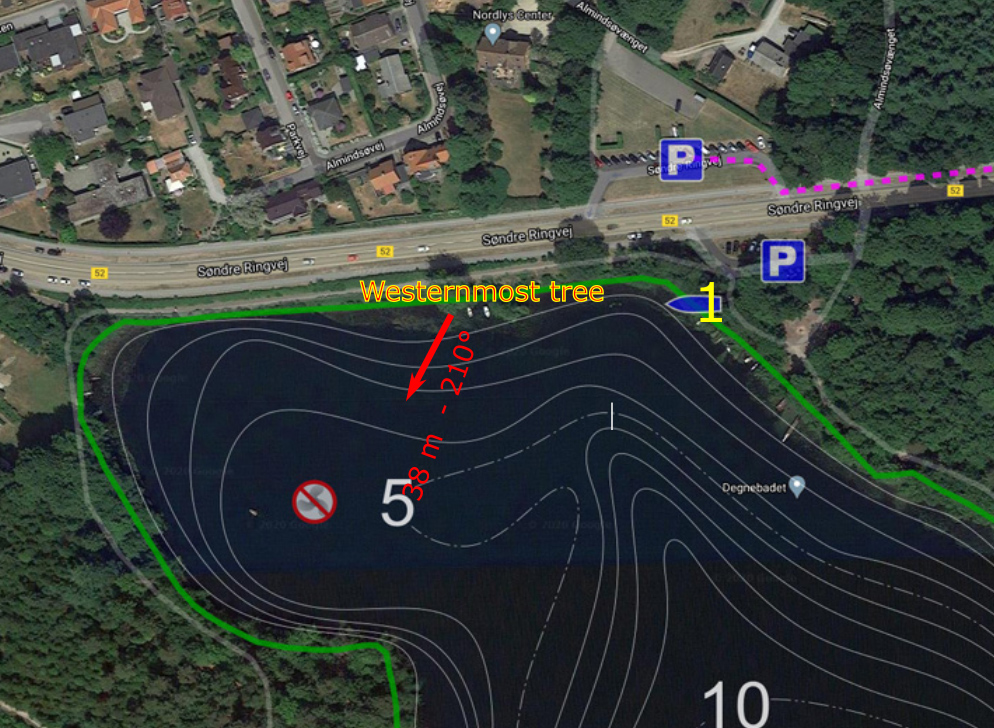
Deep points.
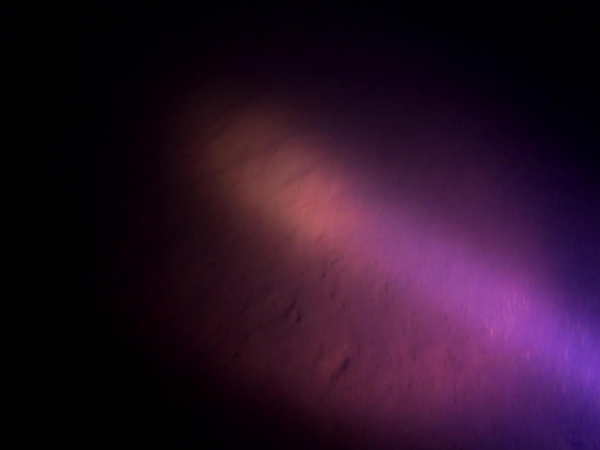 You can reach an 18,5-meter deep point 154 meters (~10 minutes of swimming) from entry point 2 and a 19-meter deep point 147/127 meters from entry point 3 and 4 respectively by using the courses given in the pictures below. Do not count on being able to spot the sloping contour below water. It looks pronounced in a map but, it is very shallow (~5 cm per meter). We do not recommend going for the 20,5-meter deep point at the middle of the lake because it will be hard to transport an injured diver away from the area (no access for cars). Be aware that it is cold (~5° C) and dark down there all year around and not very comforting for inexperienced divers (see photo at left taken at 17 meters on a bright day).
You can reach an 18,5-meter deep point 154 meters (~10 minutes of swimming) from entry point 2 and a 19-meter deep point 147/127 meters from entry point 3 and 4 respectively by using the courses given in the pictures below. Do not count on being able to spot the sloping contour below water. It looks pronounced in a map but, it is very shallow (~5 cm per meter). We do not recommend going for the 20,5-meter deep point at the middle of the lake because it will be hard to transport an injured diver away from the area (no access for cars). Be aware that it is cold (~5° C) and dark down there all year around and not very comforting for inexperienced divers (see photo at left taken at 17 meters on a bright day).
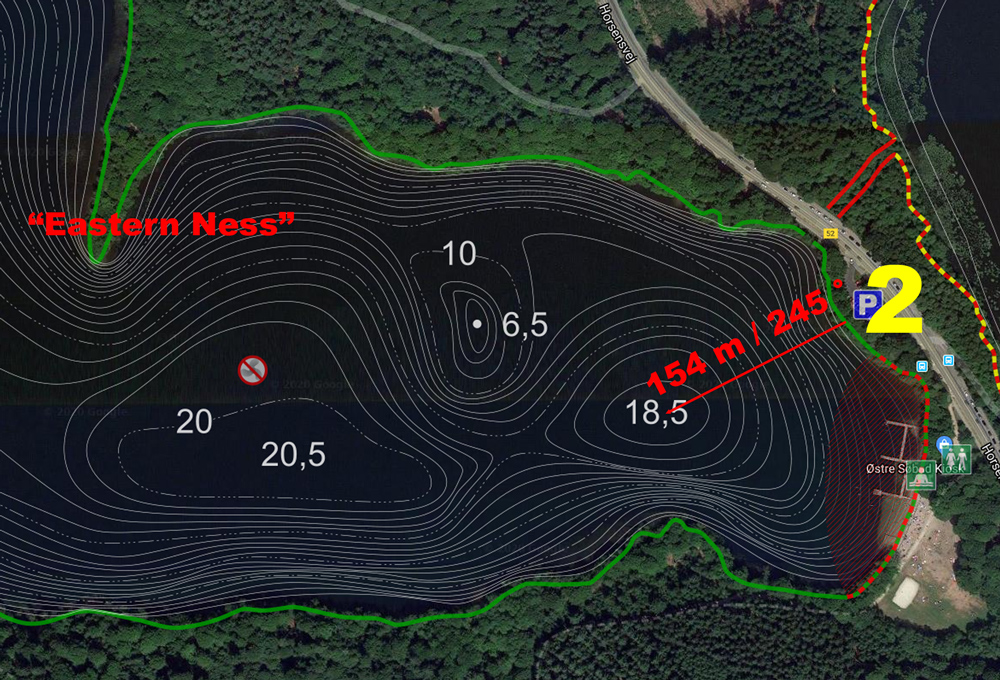
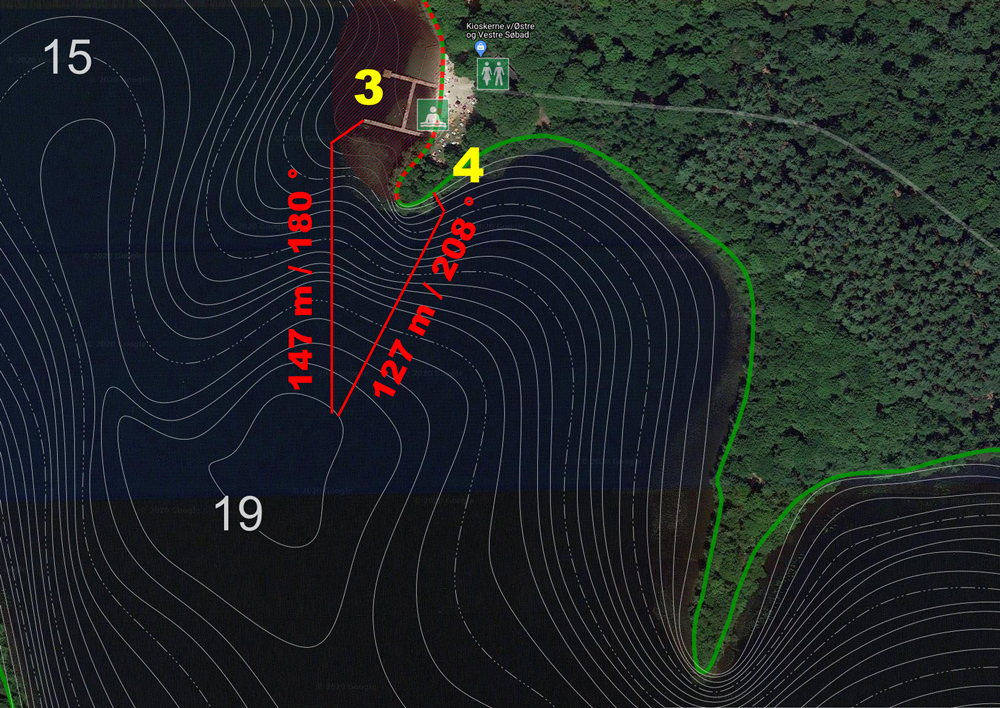
Vantage point
If you are going for the aquatic life in the reed forests you will find that it is hard to keep a group of more than 3 divers together because you will have to stop and circumnavigate plants all the time and due to low visibility. If you are going in one line, only the first diver will get to see the fish. If you swim in a formation three or more divers wide, it will be extremely hard to keep track of the most distant divers. But this is low-risk area at 0 – 4 metres depth and any diver can safely abort to the surface in case of problems. The best way is to have the divers swim in buddy teams two-by-two and just make sure that they can see their own buddy and the buddy team in front of them. Flashlights are highly recommended. Instruct your divers to surface if they lose contact with the other buddy teams. It will happen again and again. Just meet at the surface, regroup, and try again. Take turns in leading.
Points of interest are easy to find with proper instruction. Unless you are doing exercises, it is often better for the guide just to instruct the divers to stay in buddy teams and observe the bubbles through a binocular from the entry point of choice.
If you are taking divers to the deep points of the lake, it will not be in order to observe underwater plants or organisms but for training purposes. In these cases, a 2 by 2 formation with you at the front is recommended. Do not forget to establish a separation protocol. Bring flashlights to stay connected. We do not recommend bringing inexperienced divers below 10 meters depth. It is cold and dark, the risk of separation is grave, and it will not be a good experience.
Except in a few areas, it is not possible to have divers kneel on the seabed to do exercises. The seabed is soft, and any contact or just use of flutter kick will stir up mud rendering the visibility to zero. With care it is possible to kneel at the seabed close to entry point 1, though, but divers who only master flutter kick better stay at least 1 meter above the seabed.
Hazards
Almindsø Lake is a safe diving site where you would really have to look for trouble to find them. You will not get hit by motor – or sailboats, and even if wind surfers or row boats have parts that can hurt you, it is unlikely to happen. There are always people around to help bring an injured diver ashore and call for assistance. The closest hospital with ambulances is just 3 km away. Automatic Defibrillation equipment (AED) is available within 500 metres of both Entry 1 and 2.
Many years ago a fatal diving accident occurred when a diver had just exited the water onto one of the bridges and started taking off her equipment when a person asked her to go back into the water to fetch a pair of lost sunglasses. She jumped into the waters without her fins and immediately sank to the bottom. It is believed she panicked and was unable to free herself from her weight belt and unable to propel herself to the surface due to lack of fins, the auto-reaction of a diver in panic. The accident could have been avoided, had she 1) brought her fins, 2) brought a buddy or 3) done her pre-dive equipment check. Do not count on putting on your fins after you jump into deep water.
Other than that, the only hazards we can think of:
- The seabed below 4 metres is very muddy and if anyone stirs it up, visibility is lost immediately That may cause inexperienced divers to panic or to lose sense of direction. We do not recommend bringing inexperienced divers below 10 meters.
- The risk of separation from your buddy is high both during days of low visibility and because of the risk of stirring up mud. It is recommended to bring flashlights because it makes it easier to stay connected with buddies. Also, do not forget to establish a separation protocol: What to do if you get away from each other.
- Thermoclines are pronounced. Even in the summertime you will get hit by sudden cold at 4 – 8 metres. Dry suits are recommended for dives below 4 metres. Do not forget to warn divers who have never experienced thermoclines.
The last hazard is:
- It can be difficult to bring an unconscious diver ashore through areas of mud and reed. If you can, go for one of the beaches with sand, one of the entry-/exit points or at least an area without visible reed.
In case of emergencies
This section is addressed at divers with Rescue Diver Certificate or above.
The basic principles apply:
| Step | Action | Interpretation |
| 1 | Establish security | Show authority and take control of the situation. Bring the diver(s) ashore. |
| 2 | Assess the injured diver(s) | Or make sure someone qualified does it. |
| 3 | Summon Medical Emergency Service | See below. |
| 4 | Provide EFR | Provide CPR or whatever it takes to keep the diver(s) alive until Medical Emergency Arrives. |
If you are in the water with the injured diver(s) bring him/her to the surface, establish free breathing channel as taught on the Rescue Diver Course and swim the diver ashore while yelling for help. If you can, go for one of the beaches with sand, one of the entry-/exit points or at least an area without visible reed. If you are not in the water, there is probably no alternative to have someone or you enter water to bring the injured diver(s) ashore but unless you cannot swim that should be safe. Make sure that person knows how to do it and is aware of the dangers of approaching a diver in panic.
Once you have the diver(s) ashore you are likely to have dozens of people around who can help you contact Medical Emergency Service, fetch AED or Oxybox or whatever the situation requires. Get this started immediately when you have assessed the diver(s) and start giving EFR including CPR if required.
Further info on the resources available is given below.
National emergency phone number: 112
Once you determine that medical assistance is required, immediately have someone call this number while you or someone else initiate First Aid. Ask the caller to explain to the medical service:
- Where we are (position).
- It is a diving accident where the injured persons have been brought ashore
- How many persons are affected?
- Possible kind of injury
- How to call back
- Report back to you when the call is completed
As for possible kind of injury, ask the caller to specify (as assessed by you)
- Cardiac Arrest,
- Unconscious diver with a heartbeat,
- Suspected Decompression Illness or
- Other injuries and their nature
As for position, the medical emergency service is unlikely to know where “Almindsø Lake” is. Ask the caller to use the term “Silkeborg South, Almindsø Lake North/South Side, East/West/Middle” or “Swimming Resort East/West” if applicable. Entry points 1, 2, 3 and 4 can be reached by car. Helicopter access is probably not possible anywhere close enough to the lake.
The medical emergency service is likely to send an Emergency Medical Unit from Silkeborg Hospital 3 km away with proper equipment such as AED and Oxybox rather than bring the injured diver to the hospital.
The nearest decompression chamber is located at Rigshospitalet in Copenhagen, 200 km away by air. If required, the emergency service will organise for the diver to be transported there - by helicopter if needed. A recent incident in Kolding demonstrated that the diver could enter decompression chamber 45 minutes upon arrival of the Emergency Medical Unit.
Access to AED, Automatic External Defibrillator
At least 4 AED’s are available within a few minutes of driving from the lake. Although the Emergency Medical Unit will bring one it is likely that you can have someone nearby fetch one faster.
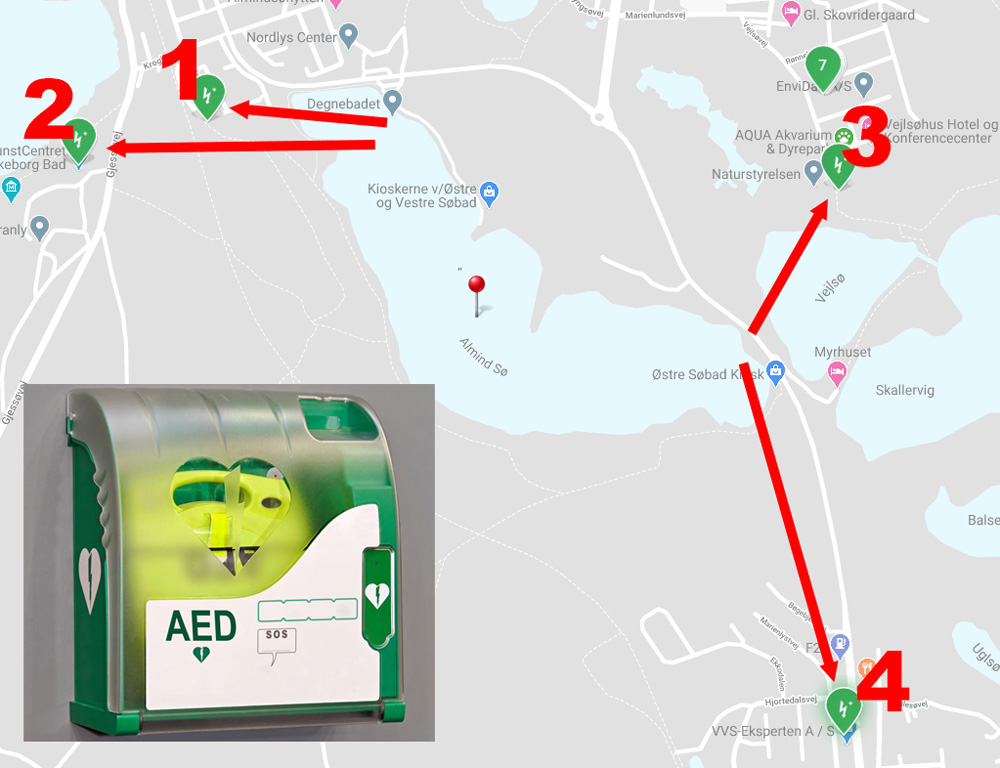
The AED’s are available at the following addresses (all public 24h access)
| 1 | Aggerholm Kroghsvej 18 8600 Silkeborg |
Forest side of house located next to path leading to Almindsø Lake, “Aggerholm beach” |
| 2 | Kunstcentret Silkeborg Bad Gjessøvej 40 A 8600 Silkeborg |
When entering the art area, seach along the large building’s right side. |
| 3 | Skoleafdelingen/Naturfagscenter Bygning K, Vejlsøvej 55 8600 Silkeborg |
Visible when you arrive at the Fresh Water Centre/Vejlsøhus and continue straight |
| 4 | Dansk Sygeplejeråd Marienlystvej 14 8600 Silkeborg |
Building E, at the terrace |
The availability of AED’s changes rapidly. It is probably better to ask whoever helps you to check Hjertestarter.dk or the app “Trygfonden Hjertestart”
Oxybox.
Oxybox is available at Silkeborg Scuba Club, Almindsøvænget 9, 8600 Silkeborg, 200 meters from Entry Point 1 but only with prior arrangement.
Other first aid equipment.
The area is immensely popular, and it is unlikely that bystanders should not be able to get you whatever you need for first aid from nearby cars: blankets, band aid, pain killers, scissors.
Other things to remember in case of an emergency.
- Do not forget to ask for contact details from witnesses.
- Never speculate on causes, neither to bystanders nor to the press. Just provide facts to those who need to know.
References
- Silkeborg Scuba Club/Silkeborg Frømandsklub:
- Visit Silkeborg:
- Find AED, Automatic External Defribrillator’s nearby or use the app named “Trygfonden Hjertestart”
- Silkeborg Fishing Association (Silkeborg Fiskeriforening) (Source of depth charts).
Divemaster Candidate Claus Nedergaard Jacobsen